Physical Address
304 North Cardinal St.
Dorchester Center, MA 02124
A wide variety of primary and secondary neoplasms may affect the orbit. Most orbital masses are benign and slow growing, but approximately 20% are malignant. Making the correct diagnosis may be difficult for several reasons. In children, it may be challenging to obtain an accurate history and physical examination. The presenting symptoms (and imaging findings) of different pathologic entities may overlap considerably. Nonneoplastic masses may present with visual loss and destructive changes of the orbit, raising concerns for malignancy. At the same time, some malignant tumors of the orbit may closely resemble inflammatory cellulitis, both clinically and on imaging. Some orbital lesions have a high association with systemic and genetic disorders, and, in these cases, represent just the “tip of the iceberg.” Diagnosis of an orbital lesion behooves the interpreter to diligently search for concurrent lesions elsewhere in the body.
A precise and timely diagnosis of an orbital mass can be crucial for successful treatment and prevention of blindness. Imaging plays an integral role, and, at times, more than one imaging modality may be required to allow delineation of the lesion's morphology and extent. Proper utilization of imaging modalities, in particular ultrasonography (US), computed tomography (CT), magnetic resonance imaging (MRI), positron emission tomography (PET), and, in selected cases, conventional angiography, should be thoughtfully considered. Newer advanced imaging technologies contribute to the precise diagnosis of orbital pathology. The radiologist should recommend the best imaging modality to be used in specific clinical scenarios.
US is primarily a tool used by ophthalmologists in the assessment of diseases of the globe and extraocular muscles (EOMs). This modality is especially valuable for the evaluation of young children with leukocoria but may be suboptimal in assessing the full extent of extraocular and intracranial spread of a primary ocular mass.
CT is a very effective tool in the diagnosis of pediatric orbital disease. It is widely available and often may serve as the initial imaging modality for evaluation of acute proptosis, orbital cellulitis, and trauma. CT is excellent at depicting calcifications and evaluating potential bony involvement. Current CT equipment allows for rapid acquisition of high-resolution images in the axial plane, with near real-time additional computed reformation images in the coronal and/or sagittal planes, thus avoiding the need for direct acquisition of images in orthogonal planes. Three-dimensional (3D) reformations are important for surgical planning and better depiction of orbital volumes ( e-Fig. 7.1A ). The data acquisition is rapid enough to obviate the need for sedation in many cases. Pediatric CT use has declined in recent years due to the continued trepidation regarding potential deleterious effects of radiation.
Many orbital lesions are optimally imaged utilizing MRI, especially since the advent of surface coils and fat suppression (FS) techniques. Protocols for orbital imaging include high-resolution, small field of view (FOV) thin-slice T1-weighted (T1W), T2-weighted (T2W), and postcontrast-enhanced (CE) sequences in the orthogonal planes.
Utilization of FS is essential when imaging the orbit, as it allows better tissue discrimination and distinction from intraorbital fat and better assessment of the bone marrow within the bony orbit. Diffusion-weighted imaging (DWI) plays an important role in further characterizing the tissues within and around tumors. Diffusion sequences based on nonecho planar principles and on parallel imaging produce images of better quality with less geometric distortion. Apparent diffusion coefficient (ADC) mapping may help in the differentiation of benign and malignant lesions and may play a role in the grading of malignancies as poorly differentiated versus well differentiated. DWI/ADC can increase the conspicuity of early bone marrow infiltration ( e-Fig. 7.1B ). Increased ADC values within a diffusion-restricting mass, after the initiation of therapy, usually indicates a favorable response to therapy. Arterial spin labeling (ASL) is a noninvasive method utilizing magnetized protons/water molecules in arterial blood as a tracer ( e-Fig. 7.1C ). It allows measurement of tissue perfusion and may be helpful in the delineation of high-flow vascular lesions, benign and malignant, and in the potential assessment of treatment response. Both DWI and ASL imaging may help to pinpoint the most aggressive component of an orbital lesion (with restricted diffusion and increased perfusion) and help to target biopsy sites to allow successful tissue sampling. Constructive interference steady-state (CISS) is a heavily T2W volumetric sequence that allows isotropic image reformations in any plane, and exquisite depiction of minute lesions ( e-Fig. 7.1D ).
Meticulous attention should be paid for the presence of bone erosion and possible intracranial invasion. Tumor extension through the orbital foramina and fissures is better delineated on MRI, whereas erosive bony changes are better depicted on CT. CT and MRI are complimentary imaging techniques in the evaluation of orbital tumors, and, in some cases, both may be indicated for proper and complete evaluation of complex orbital masses. Most protocols for imaging of orbital tumors include brain imaging in the evaluation of potential intracranial extension or in the search for additional lesions. When planned in advance, CT and MRI may also allow for intraoperative navigation, thereby assisting the surgeon with lesion localization in the operating theater. PET imaging and recently introduced hybrid PET/CT systems may be successfully utilized in assessing malignant orbital lesions. Most malignant orbital masses demonstrate increased uptake of 18 F-fluorodeoxyglucose (FDG) ( e-Fig. 7.1E ). PET/CT is most often helpful in monitoring therapeutic response, particularly if a residual mass remains on MRI after completion of therapy. Residual or recurrent active disease will continue to exhibit increased uptake of FDG, while masses with inactive, scarred tumor will show no uptake on PET. PET/CT can also identify other areas of involvement remote from the orbit, which can be seen with metastases and lymphoma. Metaiodobenzylguanidine (MIBG) scintigraphy is mainly used for the detection of distant neuroblastoma (NB) metastases ( e-Fig. 7.1F ). Recently introduced optical coherence tomography (OCT), a noninvasive method based on the utilization of near-infrared light, is remarkable for very good tissue penetration and excellent resolution. OCT has recently been applied in the imaging of optic pathway gliomata and retinal lesions.
A combination of imaging findings, along with clinical signs and symptoms, may narrow the differential diagnosis, although the definitive diagnosis is almost always based on histopathologic findings.
The following discussion of orbital pathology imaging is divided into four categories: (1) ocular lesions, (2) optic nerve sheath lesions, (3) primary orbital lesions, and (4) lesions that secondarily involve the orbit.
Retinoblastoma (RB) is the most common intraocular pediatric tumor, arising from retinal cone precursor cells. This tumor typically affects children younger than 4 years of age. Even though RB is considered a congenital type of malignant tumor, it is rarely recognized in neonates. Attempts to detect small fetal ocular lesions in utero in high-risk fetuses have, to date, been unsuccessful. Loss or mutation of RB genes ( RB1 gene located on chromosome 13 band q14) causes absence of RB control protein and subsequent uncontrolled cell division and tumor growth. Two forms of RB—germline (familial or sporadic) and somatic sporadic—differ in their clinical presentations and prognoses. Germline RB may be autosomal dominant (familial), but is more likely to result from a new sporadic mutation. Familial RB usually manifests as bilateral multifocal disease, but in 10% to 15% of patients with unilateral involvement, a germline mutation can be found. Familial RB clinically presents at an earlier age (mean age, 6 months). Patients with heritable RB1 mutations have increased risk (progressive throughout their lifetime) of the development of other malignancies. This risk is tripled in patients who have undergone radiation therapy. Secondary tumors include osteogenic and soft tissue sarcomas, leukemia, and malignant melanoma. Secondary non-ocular tumors are the leading cause of death in these patients, rather than the primary RB itself. Patients with heritable RB are at a 50% risk for the transmission of the disease to their offspring.
Sporadic RB is usually solitary, unilateral, and associated with postzygotic somatic mutation of the RB1 gene. This type of RB is usually present in older children (the average age at presentation varies from 13–18 months). Genetic testing is indicated in all patients with RB. Patients with sporadic noninvasive intraocular tumors have an excellent prognosis, with a survival rate greater than 90% in countries with resources to provide modern treatment.
Recent advances in RB treatment have resulted in a new approach to tumor classification. The International Retinoblastoma Classification Grouping is based on expected results of modern chemotherapy regimens and predicted salvage of the globe. There are several variants of this classification, which are based on tumor size, location, and associated seeding ( Box 7.1 ). The tumors range from group A (RB less than 3 mm) to group E (massive destructive RB) ( Fig. 7.2A ). The pathologic TNM system for RB describes important prognostic information about tumor spread through the sclera into the orbit, invasion of the optic nerve, and presence of distant metastases.
Group A—Retinoblastoma < 3 mm
Group B—Retinoblastoma > 3 mm, macular location, or minor subretinal fluid
Group C—Retinoblastoma with localized seeds
Group D—Retinoblastoma with diffuse seeds
Group E—Massive retinoblastoma necessitating enucleation
Notes: This classification is based on tumor size, location, and associated seeding. This new classification system is designed to simplify grouping and assist in predicting treatment outcomes.
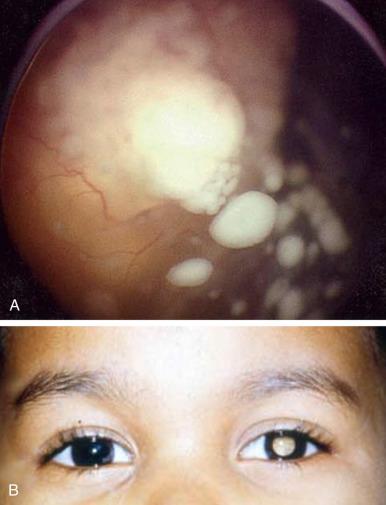
RB may present with a variety of symptoms, the most frequent clinical signs being that of leukocoria ( Fig. 7.2B ) and strabismus. Leukocoria (or white pupillary reflex) is the most common presenting sign of RB and reflects replacement of vitreous by tumor tissue. Retinal hemorrhage may obscure the visibility of the underlying mass on clinical exam; therefore every unexplained retinal hemorrhage in a young child requires mandatory imaging assessment. Strabismus is usually related to a tumor located within the macula. In contrast to leukocoria, tumors presenting with strabismus as their initial sign are associated with a higher survival rate and a higher chance of salvage of the globe.
Clinical presentations may differ depending on patterns of tumor growth. Endophytic tumors, which arise from internal retinal layers, grow anteriorly into the vitreous, with resultant tendency to vitreous seeding. Exophytic tumors, which arise from external retinal layers grow into the subretinal space and tend to have retinal detachment, earlier choroidal involvement, and increased risk of metastatic spread. Most tumors develop mixed patterns. A rare diffuse form of RB occurs in 2% of cases and manifests by diffuse infiltrative growth within the retina, without noticeable nodular mass, and without intralesional calcifications. This diffuse infiltrative type of RB presents at a later age, with the clinical symptoms at times mimicking an inflammatory process such as pseudoinflammatory glaucoma.
Imaging may reliably distinguish RB from a host of other conditions that also may present with leukocoria (persistent hyperplastic primary vitreous [PHPV], retinopathy of prematurity [ROP], congenital cataract, Coats disease, and acquired toxocariasis). In many RB centers, ocular US has replaced orbital CT for initial disease assessment. Three-dimensional high-frequency US is sufficient for assessment of tumor and calcifications but is less suitable for the evaluation of extraocular spread. RB is readily visible on US as an echogenic irregular retinal mass with focal acoustic shadows. CT is an excellent tool for depicting ocular calcifications ( Figs. 7.3A and B ), but its use in RB evaluation has decreased due to concerns of associated radiation risks. MRI has become a relatively quick and convenient modality in the evaluation of RB. A variety of tailored MRI sequences are beneficial in illustrating RB morphology and extension. The malignant, markedly cellular nature of this neoplasm (composed of immature retinoblasts) is confirmed on T2W and DWI sequences ( Figs. 7.3C and D ), whereas intraocular hemorrhages and calcifications are best depicted on gradient echo (GE) sequences. Essential detection of the aggressive features of advanced disease, such as invasion of the postlaminar optic nerve or anterior chamber, can be best demonstrated on contrast-enhanced sequences, although are best demonstrated histologically on the enucleated specimen. It is essential to thoroughly search for even subtle choroidal thickening, and abnormal uveal or optic nerve enhancement ( Fig. 7.3E ). At times, retinal detachment and hemorrhage may be indistinct from tumor margin; therefore even the most modern imaging techniques may underestimate the degree of tumor extension.
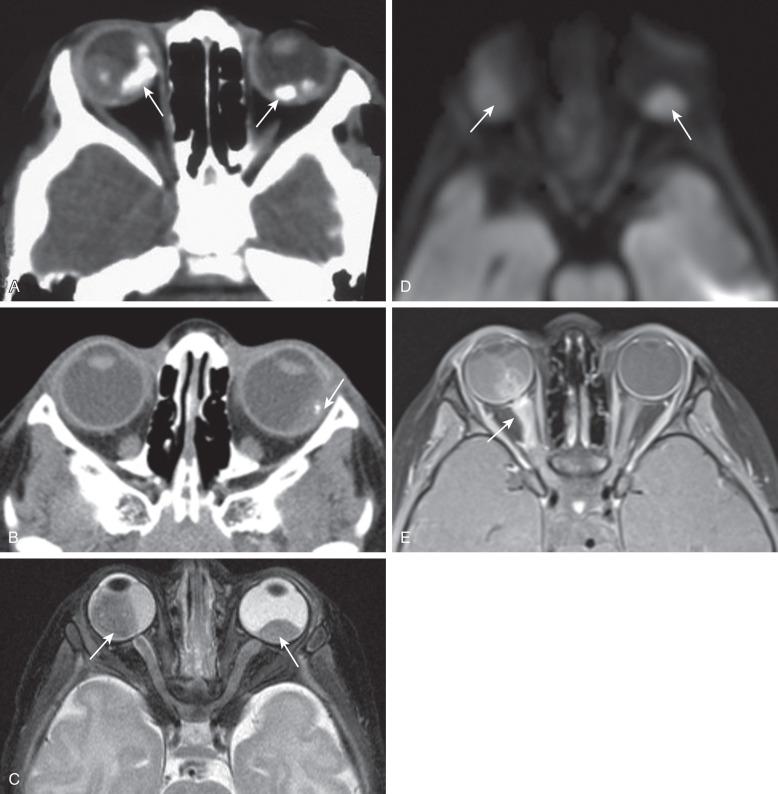
Advanced disease may present with intraorbital, intracranial tumor extension and/or with distant metastases. Distant osseous metastases from RB can be found in the skull, spine, and long bones, with focal and diffuse involvement of the bones' marrow ( e-Figs. 7.4A and B ). Leptomeningeal and parenchymal metastases may occur ( e-Fig. 7.4C ). Whole-body MRI or conventional whole-body bone scan can be performed in the metastatic workup. Orbital or intracranial secondary tumors may often be differentiated from primary advanced metastatic RB lesions by their different imaging features ( e-Fig. 7.4D ). MRI is a valuable tool for disease monitoring and in the evaluation of treatment response but does not replace an examination under anesthesia by an experienced ophthalmologic oncologist. Vitreous seeding is the leading cause of treatment failure requiring enucleation and is almost below the threshold level of detection of present MRI modern day scanning techniques.
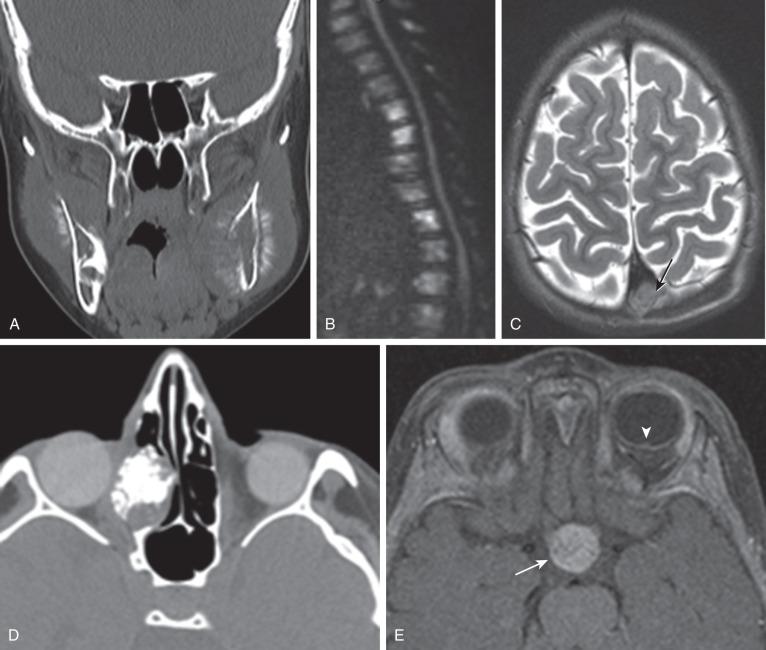
Trilateral (single midline) and quadrilateral (occurrence with a second midline tumor) RB refer to the uncommon association (3%–8%) of bilateral RB (rarely with unilateral RB) with intracranial histologically similar primary intracranial neuroectodermal tumor, most often in the pineal region. Suprasellar location of trilateral tumor has been reported with increased frequency in young patients with the unilateral familial form of RB. These lesions usually present within a year of the initial discovery of the ocular lesions, although, in a minority of cases, may be seen at the time of RB diagnosis ( e-Fig. 7.4E ). Diligent search for potential associated intracranial tumor should be performed during the first 4 years from the time of diagnosis. The diagnosis of trilateral RB had been associated with a dismal prognosis. However, early detection of intracranial lesions, and aggressive strategies including stem cell transplant, may improve cure rates.
Over the past several decades, standard treatment for RB has evolved from prior methods of surgical enucleation or external radiation. Most RB referral centers are now using alternative therapies that are aimed at eye salvage and avoiding the risks inherent with radiotherapy. These methods include systemic chemotherapy, and intraarterial and intravitreous chemotherapy, along with focal treatments (eye-sparing radiotherapy [local plaque radiation], laser photocoagulation, and cryotherapy) as the primary treatment modality, especially when tumors are small.
Medulloepithelioma is another pediatric intraocular tumor that may present with leukocoria. This tumor is histologically distinct from RB and represents a rare embryonal type of neoplasm arising from the nonpigmented epithelial lining of the ciliary body. Some authors consider poorly differentiated medulloepitheliomas to be under the category of primitive neuroectodermal tumor (PNET). Patients are usually diagnosed in the first decade of life (at a mean age of 6 years of age). Clinical signs and imaging features of medulloepithelioma may closely resemble those of an RB. The lesion presents as a nodular enhancing intraocular mass arising from the ciliary body and may reveal internal calcifications ( Fig. 7.5 ) and may restrict on DWI. Retinal detachment is common. Tumors may be benign or malignant, but metastatic disease is uncommon. Medulloepitheliomas have been divided into two types, teratoid and nonteratoid (diktyoma), based on their histology. More complex teratoid medulloepitheliomas are composed of heteroplastic elements, including cartilage, which may have associated calcifications, whereas the nonteratoid diktyoma presents as a well-defined, noncalcified mass, with associated diffuse contrast enhancement.
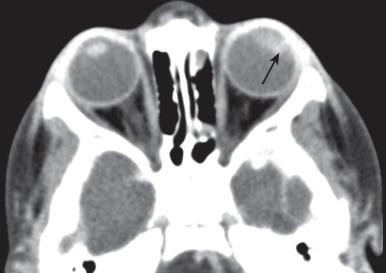
Many neurocutaneous disorders (phakomatoses) have typical ocular masses that may or may not be visible with imaging techniques. These lesions represent hereditary hamartomas, which are composed of tissues with limited capacity for proliferation. Examples may be seen in the setting of tuberous sclerosis (TS), neurofibromatosis (NF), as well as Sturge–Weber (SW) and von Hippel–Lindau (VHL) diseases.
Ocular manifestations of TS include astrocytic hamartoma of the retina and optic disc. These lesions have a typical appearance on ophthalmologic examination; however, they may calcify as patients age and may resemble drusen when located on the optic disc. On high-resolution T2W imaging, hamartomas of TS are detectable as small hypointense nodules within the globe ( e-Fig. 7.6A ).
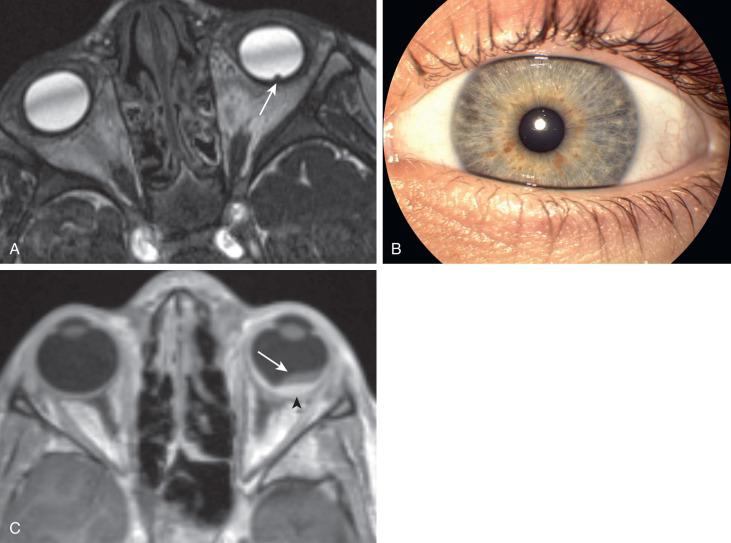
Ocular stigmata of NF may present as macrophthalmosis and neuronal hamartomas of the iris, called Lisch nodules, which only occur with NF type 1 ( e-Fig. 7.6B ). Lisch nodules can only rarely be visualized with imaging.
Patients with SW syndrome and VHL disease may have ocular vascular hamartomas ( e-Fig. 7.6C ). Choroidal vascular malformations (formerly known as hemangioma), typical for SW syndrome, may be diffuse or localized, and can simulate melanoma on fundoscopic exam. These lesions may be differentiated from one another on MRI examination. Choroidal vascular hamartoma demonstrates T1W and T2W hyperintensity, which is opposite to the T2W signal characteristics expected with melanoma (hyperintense T1W signal and a hypointense T2W signal). Ocular manifestations of VHL consist of retinal angiomatosis, which may cause severe complications including retinal detachment and ocular destruction, and usually present later in childhood or in early adulthood (second and third decades of life).
Disc drusen are nonhamartomatous subretinal lesions without astrocytic hyperplasia. They consist of intrapapillary, partially calcified hyaline bodies that form concretions of unknown nature. Drusen are likely the most common etiology for congenital bilateral elevation of the optic nerve discs. Drusen may be detected on fundoscopic evaluation or may be seen as an incidental finding on imaging. In both scenarios, it is important to establish the benign nature of disc elevation so as not to confuse drusen with true papilledema. Drusen may be diagnosed by US, which demonstrates foci of increased echogenicity, or these lesions can be seen on CT as punctuate calcifications within the optic nerve heads ( e-Fig. 7.7 ). MRI demonstrates isolated mild protrusion of the optic discs into the vitreous without perioptic CSF space enlargement or other imaging features of papilledema. Clinically, drusen are usually asymptomatic and only rarely may be associated with slowly progressive visual loss.
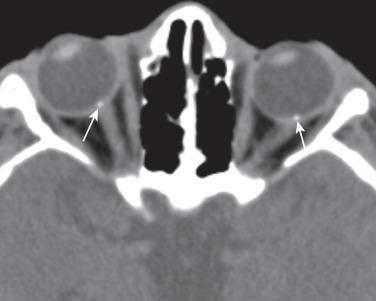
Optic nerve-sheath complex lesions include neoplasms of the optic nerves (gliomata), optic nerve sheaths (meningiomas), or rare cases of intraconal peripheral primitive neuroectodermal tumors (pPNETs).
Optic nerve glioma (ONG) is the most common primary neoplasm of the optic nerve in children. ONG may be seen in the setting of NF1 ( Fig. 7.8A ) or may present as an isolated tumor (nonsyndromic) ( Fig. 7.8B ). ONGs, which are associated with NF1 (also see Chapter 35 ), are most often bilateral lesions that may involve the optic nerve and surrounding subarachnoid space, and are remarkable for their low-grade nature and favorable prognosis. Nonsyndromic ONGs are usually unilateral and histologically are either pilocytic or fibrillary astrocytomas. The mortality rate for these tumors is approximately 5% when the tumor involves only the optic nerve, but hypothalamic involvement portends a more ominous prognosis. Despite their benign histology, some series report mortality rates approaching 50%.
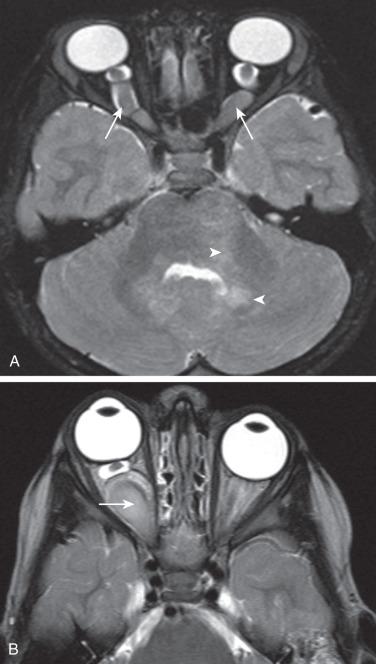
Orbital meningioma is not a common pediatric lesion, but can be seen in patients in the first decade of life. It differs in many ways from adult meningioma. Meningioma of the orbit may be seen more frequently in children than in adults, and tend to grow more rapidly and to a larger size, undergo malignant changes, and have a greater rate of recurrence. Orbital meningioma may be a primary tumor of the perioptic space (pediatric primary optic nerve sheath meningioma [PPONSM]) ( e-Figs. 7.9A and B ). PPONSM is the most common form seen in children, possibly due to early presentation with visual symptoms, but may be poorly discernable on imaging in its early stages and may present only with slowly progressive optic nerve atrophy ( e-Fig. 7.9C ). Perioptic meningioma in children is associated with NF2 with greater incidence than in adults. Detection of PPONSM in a child requires a thorough search for NF or rare meningiomatosis. Meningioma may occur in an extraconal location arising from the orbital wall periosteum. Meningioma may also extend into the orbit from a primary intracranial meningioma ( e-Fig. 7.9D ) arising from the cavernous sinus, falciform ligament, anterior clinoid process, sphenoid wing, etc. On CT, meningioma may appear as a hyperattenuating/isoattenuating mass containing internal stippled calcifications. It is often associated with bony changes, including hyperostosis, enlargement of the optic canal, and occasionally pneumosinus dilatans ( e-Fig. 7.9E ).
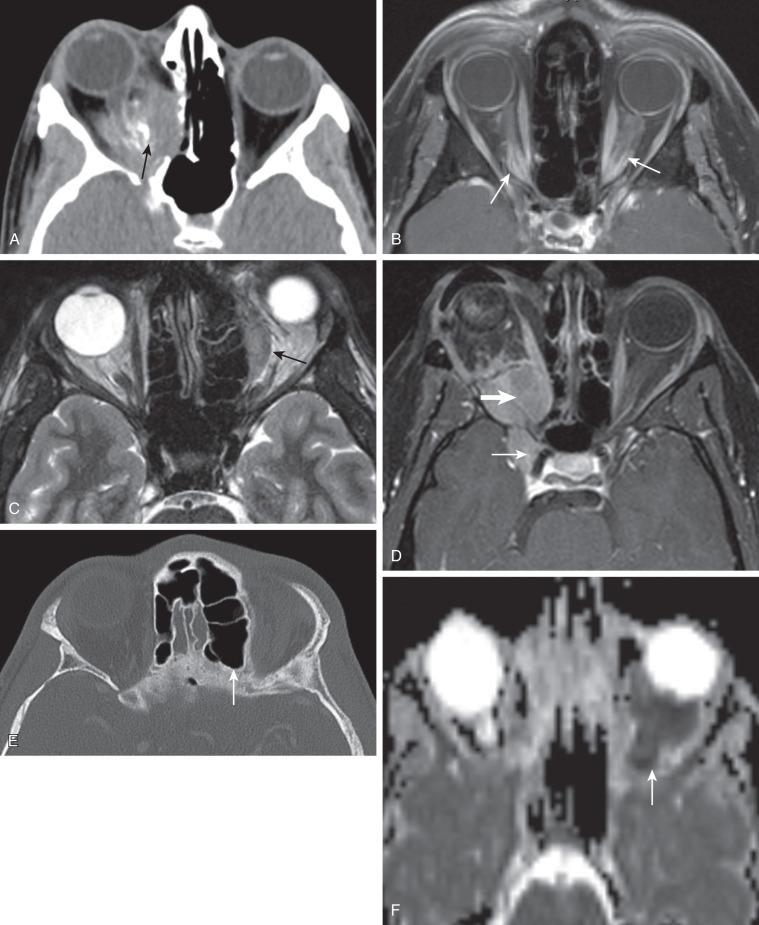
The tram-track sign, which reflects a thickened optic nerve sheath, is a common imaging feature of perioptic meningioma. MRI is the most accurate imaging modality to diagnose and follow patients with meningioma. Most meningiomas demonstrate isointense/hypointense signal on T1W imaging, variable signal on T2W imaging, as well as avid enhancement on contrast-enhanced sequences, as well as restricted diffusion on DWI due to their increased/dense cellularity ( e-Fig. 7.9F ). Younger patients may have a higher incidence of intracranial extension.
Peripheral primitive neuroectodermal tumor (pPNET) is malignant tumor of neuroepithelial origin that arises outside of the central nervous system. An orbital location is extremely rare, but most reported cases do occur in children. It appears that pPNET is the least aggressive subtype of tumor among other similar small cell tumors, with a favorable prognosis seen after complete tumor resection.
Histopathologically, pPNETs demonstrate small blue round cells, and many authors consider pPNET and extra-osseous Ewing sarcoma at opposite ends of the same spectrum due to their similar histopathologic features and chromosomal rearrangements with translocation (q24; q12). This rare tumor of the orbit presents as an enhancing, T2W hypointense intraconal lesion with restricted diffusion ( e-Fig. 7.10 ). Treatment usually includes globe enucleation, high-dose chemotherapy, and stem cell transplantation. Orbital Ewing sarcoma can also represent metastatic disease from a primary Ewing sarcoma elsewhere in the body.
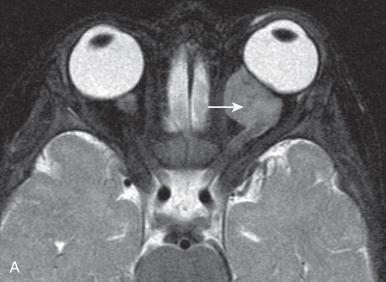
Primary optic nerve tumors are not the only cause of optic nerve enlargement. Other causes include nonneoplastic conditions such as inflammatory pseudotumor, optic neuritis, and sarcoid granulomata. Enlargement of the optic nerve-sheath complexes/dilated perioptic space may be related to increased intracranial pressure, posttraumatic perineural hematoma, or leukemic infiltration or may represent a normal variant.
Become a Clinical Tree membership for Full access and enjoy Unlimited articles
If you are a member. Log in here